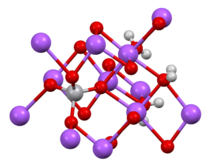
| |
| Names | |
|---|---|
| IUPAC name
Sodium vanadate(V)
| |
| Other names
Sodium vanadium oxide
| |
| Identifiers | |
| |
3D model (JSmol)
|
|
| ChEBI | |
| ChEMBL | |
| ECHA InfoCard | 100.033.883 |
PubChem CID
|
|
| RTECS number |
|
| UNII | |
CompTox Dashboard (EPA)
|
|
| |
| |
| Properties | |
| Na3VO4 | |
| Molar mass | 183.908 g/mol |
| Appearance | white powder |
| Density | 2.16 g/cm3, solid |
| Melting point | 858 °C (1,576 °F; 1,131 K) |
| 22.17 g/100 mL | |
| Solubility | insoluble in ethanol |
| Structure | |
| cubic | |
| Thermochemistry | |
Heat capacity (C)
|
164.8 J/mol K |
Std molar
entropy (S⦵298) |
190 J/mol K |
Std enthalpy of
formation (ΔfH⦵298) |
−1757 kJ/mol |
| Hazards | |
| Occupational safety and health (OHS/OSH): | |
Main hazards
|
Harmful. |
| NFPA 704 (fire diamond) | |
| Flash point | Non-flammable |
| Lethal dose or concentration (LD, LC): | |
LD50 (median dose)
|
330 mg/kg (oral, rat) |
Except where otherwise noted, data are given for materials in their standard state (at 25 °C [77 °F], 100 kPa).
| |
Sodium orthovanadate is the inorganic compound with the chemical formula Na3V O4. It forms a dihydrate Na3VO4·2H2O. Sodium orthovanadate is a salt of the VO3−4 oxyanion. It is a colorless, water-soluble solid.[2]
- ^ "Archived copy". Archived from the original on 2016-03-04. Retrieved 2017-09-28.
{{cite web}}: CS1 maint: archived copy as title (link) - ^ Greenwood, Norman N.; Earnshaw, Alan (1997). Chemistry of the Elements (2nd ed.). Butterworth-Heinemann. ISBN 978-0-08-037941-8.
